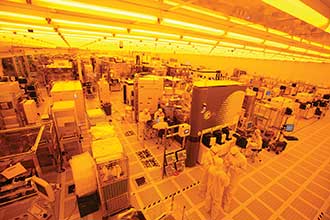A panel of industry experts weighs in on advanced manufacturing, the federal government’s role in incubating innovation and the skills missing in today’s workforce.
 Global manufacturing has undergone enormous changes in the past decade as many developing countries have joined the club of tier-one manufacturing nations, a recession stalled demand, and employment fell precipitously in leading economies. Yet manufacturing remains critical to the future of both developing and advanced worlds, driving innovation, productivity and competitiveness, and offering a pathway out of poverty.
Recent attention has focused on “advanced manufacturing,” which replaces traditional labor-intensive processes with ones based on the newest technologies. It encompasses a family of activities that depends on information, computation, software, sensing and networking, while making use of cutting-edge materials and emerging capabilities such as nanotechnology.
Advanced manufacturing is an especially potent propellant of future economic growth, distinguished by continual process improvement and rapid new product introduction. These critical features will lead to the building of lighter, more fuel-efficient automobiles, the creation of “needleless” tests for medical conditions like diabetes, and the fabrication of semiconductors with 10 times the current processing power.
To build the cars, medical equipment and silicon wafers of tomorrow, engineers will make even greater use of photonics technologies including laser sintering, advanced optics, machine vision and optical lithography.
One of the biggest advances in domestic production has been due to the rapid deployment of innovation in fracking, where photonic technology plays a minor but crucial role in sensing. Of course, that whole area is in something of a retreat with the collapse in oil prices. When asked about the domestic manufacture of goods, the first reaction is to fall back on the commonly held view that nothing is made in the U.S. anymore. In fact, with more than $2 trillion in manufacturing output, the U.S. is now the No. 2 manufacturer in the world, and holding position. Computer and electronic products, motor vehicles, fabricated metal parts and machinery constitute around $800 billion of U.S. output. In the first of these industries, advanced manufacturing has always been crucial to competitiveness. In the other areas, advanced manufacturing is slowly making in roads.
Global manufacturing has undergone enormous changes in the past decade as many developing countries have joined the club of tier-one manufacturing nations, a recession stalled demand, and employment fell precipitously in leading economies. Yet manufacturing remains critical to the future of both developing and advanced worlds, driving innovation, productivity and competitiveness, and offering a pathway out of poverty.
Recent attention has focused on “advanced manufacturing,” which replaces traditional labor-intensive processes with ones based on the newest technologies. It encompasses a family of activities that depends on information, computation, software, sensing and networking, while making use of cutting-edge materials and emerging capabilities such as nanotechnology.
Advanced manufacturing is an especially potent propellant of future economic growth, distinguished by continual process improvement and rapid new product introduction. These critical features will lead to the building of lighter, more fuel-efficient automobiles, the creation of “needleless” tests for medical conditions like diabetes, and the fabrication of semiconductors with 10 times the current processing power.
To build the cars, medical equipment and silicon wafers of tomorrow, engineers will make even greater use of photonics technologies including laser sintering, advanced optics, machine vision and optical lithography.
One of the biggest advances in domestic production has been due to the rapid deployment of innovation in fracking, where photonic technology plays a minor but crucial role in sensing. Of course, that whole area is in something of a retreat with the collapse in oil prices. When asked about the domestic manufacture of goods, the first reaction is to fall back on the commonly held view that nothing is made in the U.S. anymore. In fact, with more than $2 trillion in manufacturing output, the U.S. is now the No. 2 manufacturer in the world, and holding position. Computer and electronic products, motor vehicles, fabricated metal parts and machinery constitute around $800 billion of U.S. output. In the first of these industries, advanced manufacturing has always been crucial to competitiveness. In the other areas, advanced manufacturing is slowly making in roads.
Member Exclusive: To read the complete article, please Login or Register